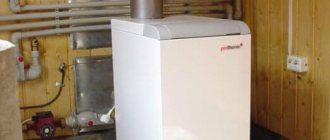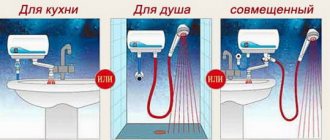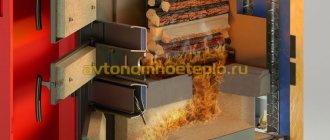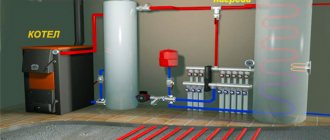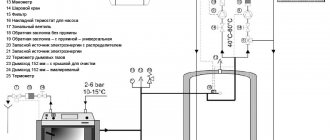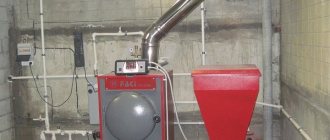Home / Gas boilers
Back
Published: November 27, 2019
Reading time: 7 min
0
3565
Connecting a gas boiler is a rather labor-intensive and complex undertaking, during which it is very important to follow all the rules for carrying out the work. Failure to comply with the requirements for installing a gas boiler in an individual home means you are likely to encounter serious problems.
Such violations can cause a fire, explosion of the gas-air mixture, poisoning by combustion products, and ineffective operation of equipment. If the boiler is wired incorrectly, the gas service will not give permission to connect and put it into operation.
Correct operation of the boiler depends on correct installation.
- 1 Basic design requirements
- 2 What documents must be prepared and who issues them?
- 3 Is it possible to install it without permission?
- 4 Requirements for the room and air exchange
- 5 Step-by-step instructions for connecting a gas boiler with your own hands 5.1 Connecting a double-circuit boiler
- 5.2 Connection diagram for a single-circuit boiler
- 5.3 Scheme with a boiler
Requirements for the room and air exchange
To ensure normal air exchange in the room when the boiler is operating, it will be necessary to equip an effective natural ventilation system that provides 3 times the hourly air exchange of the room.
When calculating the supply ventilation, the volume of air required for the combustion process is added to this indicator, the value of which is taken from the passport data.
It is important to take care of ventilation in the room with the boiler
Basic requirements for the room where the boiler will be installed:
- The smallest room height is 2.0 m, cubic capacity is 7.5 m3. In the case where two or more boilers are installed, the dimensions change to 2.5 m and 13.5 m3, respectively.
- It is not allowed to install heaters in basements, bathrooms, bathrooms, and corridors, as well as in rooms without windows.
- The walls of the boiler room must be protected with fire-resistant materials or special heat-resistant panels.
- Glazing is carried out according to the ratio per 10 m3 of room - 0.3 m2 of windows.
- The room is equipped with a protective grounding circuit.
- The cross-section of the chimney must correspond to the power of the boiler unit, and the diameter must correspond to the smoke pipe at the outlet of the boiler.
- To service the unit there must be free passages: at the front of the boiler - from 1.25 m, on the sides - from 0.7 m.
- When placing the gas duct, maintain a maximum distance from the vertical flue to the boiler - no more than 3.0 m.
Installation of solid fuel units
These units are installed in a private house in dry rooms, the dimensions of which are directly proportional to the dimensions and power of the unit. The walls of the boiler room must be plastered or covered with sheet iron. Their connection diagram implies the presence of supply and exhaust ventilation, which will provide good draft.
The boiler is installed level on a horizontal foundation covered with a layer of sheet iron. The foundation should be 10 cm larger than the base of the unit along its entire perimeter. The safety zone on the firebox side is at least 40 cm.
There are installation standards for operational safety, which are specified in the installation requirements or are freely available in open sources of information. They must be followed!
Tools and materials
To connect to the heating system you need to purchase:
- two ball valves with a coupling-fitting connection with a diameter of 50 mm;
- two bends of the same diameter;
- pressure gauge;
- safety valve;
- automatic air vent;
- two ball valves with a diameter of 15 mm;
- three steel couplings with a diameter of 50 mm;
- transitions 57 x 32 mm with a wall of 3 mm;
- bends 57 x 3.5 mm;
- chimney with gate valve;
- pipes 57 x 3.5 mm;
- heat-resistant sealant;
- plumbing winding;
- circulation pump.
Harness
The unit's piping is equipped with a safety system, which consists of a heat accumulator, a three-way valve for mixing cold water, and a thermostat. What need to do:
- place the boiler on the foundation;
- connect the heating pipes with the obligatory use of ball valves, sealing the joints with plumbing tape;
- make grounding and connect the power cable;
- install a safety system (pressure gauge, safety valve, automatic air vent);
- assemble the chimney, sealing the joints of the elbows with heat-resistant sealant;
- fill the heat exchanger with water;
- check the location of the grate, ignition valve, cleaning plug, etc.;
- Reduce the pressure in the heat exchanger to operating level;
- install the dampers in the chimney and firebox to the required position;
- carry out laying firewood.
In general, any heating equipment can be connected to a heating system with your own hands if you use the right approach and have basic knowledge and skills.
The desire to live in comfort, to enjoy the convenience of constant availability of hot water is quite understandable. The current level of technological progress can easily satisfy such a desire. There are quite a lot of convenient engineering solutions that are applicable even for a small house or one-room apartment.
The connection diagram for a double-circuit gas boiler takes into account all possibilities. You can act according to general principles or reduce fuel consumption and use a boiler for a hot water supply system or heating circuit, where it will serve as a heat accumulator.
Single-circuit
Such a device has one heat exchanger used to heat the coolant.
With its help it is impossible to prepare water for hot water supply (domestic needs). They are intended only for heating living spaces.
The units are divided into wall-mounted and floor-mounted according to the installation principle. The difference is power.
For the first ones it is limited - 100 kW ; for floor-standing ones there is practically no limit.
Wall mounted
- Attachment is made using special brackets.
Important! There must be a gap between the unit and the wall ranging from 30 to 50 cm.
- The presence of draft in the outlet pipe of the unit is checked before connecting to the chimney. The diameter of the inlet hole must correspond to the diameter of the chimney pipe. Connections must be tight.
- To prevent clogging of the heat exchanger, a water softening system is installed on the boiler pipe.
- Before connecting to the heating system, the unit must be pressure tested.
- Using a flexible hose and paronite gaskets, connection to the gas main is made.
Photo 1. Connection diagram of a single-circuit wall-mounted boiler to a heating system with a circulation pump and water heater.
Floor-standing
- The device is installed in a specially prepared and cleared place.
- A hole is made for the chimney (if there is none) and the diameters of both outlets (both the chimney and the chimney) are checked to match.
- A filter is installed to soften the water.
- The boiler is connected to the heating system and gas mains.
Attention! Due to the possible danger of work, it is recommended to entrust the connection of wall-mounted and floor-mounted units to the gas main to a specialist.
The tightness of connections is important for both types of devices.
Stage one: boiler installation
Installing a gas appliance is usually not difficult. This is the simplest stage of installation of a heating system. Manufacturers have developed detailed installation instructions for each type of boiler.
It is easier to install a floor-standing one, despite the fact that it is heavier in weight and larger in size. For wall mounting you need special brackets. They come included with the device. The diagram for connecting a wall-mounted boiler to the heating system is indicated in the instructions for the device. The most important thing is to choose the right location for installing the boiler, while also considering how the pipes will be connected to the boiler.
When choosing the location of the unit, not only ease of maintenance is taken into account. It is necessary to comply with the standards and requirements that apply to gas appliances. Their implementation guarantees the efficiency and safety of using the heating unit.
Two basic rules to follow:
- The room where the boiler will be installed must be provided with a window or window that can be easily opened if necessary.
- No devices or objects should be placed near the gas unit.
The connection diagram for a floor-standing boiler requires careful preparation of the base. The wall-mounted boiler is placed at a height of 80 cm from the floor, no closer than half a meter from the walls. These are standard operating safety requirements.
Advice. It is more convenient to mount wall-mounted gas units with an assistant to prevent distortions and facilitate installation work.
To know how to properly connect a double-circuit boiler, you need to become familiar with the conditions required for the installation of a chimney and ventilation system.
Turbo boilers greatly simplify the task because they do not require the installation of bulky chimneys and exhaust systems. This type of boiler is becoming increasingly popular today. The peculiarity of turbo boilers is the device for the forced removal of exhaust gases and the simultaneous influx of street air, like a “pipe in a pipe”. This is the safest system, as it allows you to install gas units in almost any room.
There is another type: floor-mounted parapet boilers. These are chimneyless, energy-independent units. They are used where it is impossible to build a large chimney. Parapet boilers have a closed combustion chamber, it is completely isolated from the room. In such boilers, the coolant circulates by gravity, without an electric pump. This is their main difference from turbocharged boilers with a coaxial chimney.
Dual-circuit
Dual-circuit devices are distinguished by the presence of 2 lines. The second line is designed to heat water for domestic needs, which eliminates the need for a boiler.
Wall mounted
The connection diagram for wall-mounted double-circuit boilers is not very different from single-circuit boilers. However, here four (and not two) pipes are connected , a couple of which are used to heat water for household needs.
Photo 2. Connection diagram for a wall-mounted double-circuit heating system boiler for a private two-story house.
Floor-standing
The connection of a floor-mounted double-circuit type is similar to a single-circuit one, again taking into account the presence and connection of the second pair of pipes.
Preparation for installation of gas equipment
Those who are sure that the installation of a gas heating device begins with its purchase are greatly mistaken.
We start with collecting permits. Simultaneously with obtaining the necessary papers, you should begin to select and prepare a site for installing the heating unit, while taking into account the following regulatory requirements:
In order to obtain permission to install heating equipment, you need to go through several stages:
Step No. 1: Obtaining Technical Specifications and Permits.
It is necessary to find out whether it is in principle possible to install a gas boiler in a particular apartment or house. To do this, an application is submitted to the gas service with a request to carry out such a procedure. It must indicate the estimated annual volume of gas consumption.
The document will be reviewed and as a result the applicant will receive permission to install along with the Technical Specifications or a justified refusal.
Step #2: Creating a project for the future installation.
To begin with, it is advisable to decide on the brand of meter and boiler, but you should not purchase them yet. After which an installation project is ordered. It is carried out on the basis of a previously obtained permit for specific equipment.
The document must indicate equipment connection diagrams and the laying of the main line inside the building from the gas communications connection point. Only a licensed company has the right to engage in the project.
Gas boilers are the most practical and economical option for heating premises. Can be used both in apartments and in private houses
Step No. 3: Obtaining approval from the gas service.
The new project must be agreed upon with the gas service that services the area on which the house is located. The procedure usually takes a maximum of three months and a minimum of a week.
At this stage, you can already purchase gas equipment, because in addition to the project, you must provide the following documents for approval:
- technical passport of the gas boiler;
- certificates of conformity and sanitary-hygienic;
- operating instructions for the heating device;
- expert opinion on the device’s compliance with all technical requirements.
It is very easy to obtain these documents. The manufacturer must include them with its products. At the end of the verification procedure, the applicant receives an approved project, which in this case will be stamped with a special stamp.
Installation of equipment
Before connecting gas heating boilers, secure the device. There are models that are mounted on the wall using special brackets. Larger units are mounted on a prepared floor area. It must be level and strictly horizontal.
To install a wall-mounted unit, first install the brackets, and to avoid distortions, use a building level. After installing the equipment, connect the gas to the boiler . This operation should only be carried out by specialists who have access to perform such work.
There is nothing complicated about the connection, but you need a documented conclusion of the correct connection. It can only be provided by special bodies that supervise the operation of gas pipelines and related equipment.
How to connect a gas boiler to water heating in a private house
Let's start looking at examples. In order not to duplicate information, we will consider a diagram for connecting a double-circuit gas boiler to a heating system (we use a turbocharged boiler). Single-circuit modifications are connected in a similar way, only minus the DHW circuit (which only simplifies the task). In our example, we are installing a closed-type heating system without heated floors, additional circuits and boilers.
The heating boiler connection diagram includes the following steps:
- Connection of equipment to the chimney.
- Connection to the gas main.
- Connection to water supply.
The procedure begins with marking the location for installing the boiler. A stable base is made for the floor-standing device, for example, from a concrete screed. Installation on flammable substrates is not permitted. Wall-mounted models are hung on special brackets. The fasteners must be strong enough to support the weight of the boiler.
Connection to the gas main
To connect the heating unit to the gas main, use a flexible hose connected to the gas pipe. You can also “plant” the device on a rigid metal pipe, but this is not so convenient. The circuit must include a filter that prevents the smallest debris from entering the gas units. When using volatile boilers, dielectric insulators are installed here.
Connection to chimney
Coaxial chimneys act as air intakes and at the same time ensure the removal of combustion products. Even inexperienced installers can cope with their connection.
The boiler is connected to the home chimney using pipes of a suitable diameter - they are sold in any specialized stores. The easiest way is if the heating system uses turbocharged units (with closed combustion chambers). Their advantage is that they require traditional chimneys. Instead, coaxial chimneys are used here - double, pipe in pipe.
In most cases, these chimneys are led outside the wall on which the boiler itself is mounted. It is also possible to remove them behind any other walls (with extension).
Connection to the water supply system
We continue to connect the gas boiler in a private house to an autonomous heating system. Our next task is to connect both circuits. First, let's look at the hot water supply circuit. Everything is simple here - we install a tap and a coarse filter at the inlet to avoid contamination of the secondary heat exchanger with small mechanical inclusions. We install another tap at the hot water outlet and connect a pipe to it through which water will flow to the water collection points.
This scheme is slightly complicated by multi-stage water filtration systems. Most often, they are installed immediately after the water pipe enters the household. You can do it easier - run hot water without a filter, installing it on a cold water tap. In this case, it is enough to purchase the Aquaphor Trio filtration system (there are many of them, the functionality and cleaning properties depend on the types of cartridges used).
Connection to the heating circuit
Connecting a gas boiler to the heating system with your own hands is as easy as shelling pears. For this we need:
- Two valves with check valve.
- Safety group (if it is not in the boiler).
- Expansion tank (if it is not in the boiler).
If the unit you are using does not contain a circulation pump, it must be installed on the return pipe to avoid pressure drop in the heat exchanger.
If you have a modern wall-mounted gas boiler, then it will probably have almost all the equipment we need - an automatic air bleeder, a safety valve, a circulation pump and an expansion tank. Sometimes external tanks are added to the standard tank if the heating system has a large volume. Heating units are also equipped with mechanical thermometers or thermomanometers to monitor operating parameters.
Stages of connecting gas boilers
The scheme for connecting a gas boiler to a heating system is quite complex, time-consuming and requires certain knowledge and experience. Gas boilers become more and more efficient and safe with each generation; automation and regulation become more complicated. Universal boilers are widely used, which not only heat the room, but also heat water.
Manufacturers develop leaflets and instructions that explain how to correctly connect a double-circuit gas boiler to the heating system. Despite the difficulties, you can figure out the installation stages yourself. This is much more economically profitable, because installation work is very expensive.
To figure out how to connect a gas boiler, you should break down all the steps into several stages:
- installation of the unit (or wall mounting if it is a wall-mounted option);
- work on connecting a water heating circuit;
- connection to water supply (double-circuit heating units);
- connection to the gas pipeline;
- commissioning works.
In order for the boiler to operate safely and efficiently, you need to understand the features of each stage.
Before you begin installation, you need to purchase all the necessary consumables, decide which pipes to connect the gas boiler and find out what type it is:
- Single-circuit boiler. It has one heat exchanger and is intended for heating only.
- Double-circuit boiler. Serves two heat exchangers: one circulates the coolant for the water heating circuit, the second is designed to solve the problem of hot water supply. In summer, the main circuit is turned off. Connecting a double-circuit boiler with your own hands requires care.
Heating systems are also different: closed or open types. The coolant can circulate forcibly or by gravity. However, the principles for connecting boilers to heating systems are the same.
Wall-mounted gas appliances are very easy to install. They are small in size and come complete with all the necessary equipment that will later be needed during installation. For safe operation, many modern gas units are equipped with special sensors that signal problems in the system. This allows you to eliminate minor breakdowns in a timely manner and thereby avoid serious and costly repairs of the entire system. Therefore, boilers that at first glance seem difficult to maintain, in fact, significantly save money on their repair.
Installation of a floor-standing unit
Stationary double-circuit heat generators burning natural gas are divided into 2 types - non-volatile and requiring power supply. The latter are connected to heating and electricity in the same way as their wall-mounted “brothers”.
A non-volatile floor-standing boiler heats DHW water using a copper or stainless steel coil built into the main heat exchanger. The heater's equipment is minimal - a burner, automatic safety system and a heat exchanger, nothing else. In addition to the cranes listed in the previous section, for installation you will need to buy:
- safety group with a safety valve designed for the operating pressure of the heat generator (indicated in the passport);
- circulation pump;
- expansion tank of calculated volume (10% of the total amount of coolant).
The diagram for connecting a heating unit to a closed-type heating network is shown in the picture.
A few words about how to connect a double-circuit floor-standing boiler to a gravity heating system. Here you will need an open expansion tank with an overflow, but a pump and safety group are not needed. Pipe diameters are at least 40 mm, laying is carried out with a slope of 5 mm per 1 linear meter. highways. The heater is the lowest point of the system, and the open tank is placed at the highest. If electricity is available, forced circulation can be organized using a pump installed on the bypass.
Integration of a dual-circuit heater into a gravity system with the possibility of forced circulation from a pump
Third stage: connecting the gas boiler to the water supply
Modern double-circuit gas boilers are connected to the water supply system. Fundamentally, these works do not differ from connecting to a heating circuit. Differences in pipe diameters and taps. In places where cold water is supplied, special filters are installed to prevent dirt and debris from entering the unit. There are many examples of boilers failing due to poor quality water. To simplify installation and ensure quick replacement of shut-off valves, special detachable connections are used - “American ones”.
In gas units, cold water is supplied to the left, hot water to the right (relative to the center). When connecting single-circuit gas boilers to the heating system, water supply networks will only be needed to pump water into the water circuit.
Double-circuit boiler and indirect heating boiler
This combination began to appear among homeowners who were not satisfied with the performance of the DHW circuit of a gas heat generator. And it is not surprising, because a medium-power unit is capable of producing 10-13 liters of hot water per minute, which is not enough to simultaneously supply two consumers - a kitchen sink and a shower stall.
Another thing is that the purchased indirect heating boiler is connected to a double-circuit boiler in a perverse way, shown in the diagram. An imitation of the flow is created by an additional circulation pump, which is turned on and stopped by a signal from the thermostat.
This scheme does not work correctly and here's why:
- The heating unit produces water from the DHW circuit with a maximum temperature of 60 °C. Passing through the boiler coil, it will never be able to heat its contents (which is 150-200 liters) to the same temperature.
- From the boiler heat exchanger, hot water of 50-55 °C flows into the second circuit of the boiler instead of cold. It is instantly heated by the burner, which is switched off by a signal from the temperature sensor. But due to the flow, the switching on occurs again after a few seconds - “clocking” occurs (start-stop mode), which reduces the resource of the heat generator.
- The boiler heats up much longer than expected - from 40 minutes to 2 hours, depending on the power. During this period, the heating is turned off - the unit is occupied by the DHW circuit (this is discussed above in the video). The house is cooling down.
- A harmful bacterium that lives in warm water, Legionella, multiplies in the storage tank. It can be removed by heating the boiler weekly to maximum temperature, which is impossible to achieve.
Correct wiring diagram for an indirect boiler with a heat source
In order for the indirect heating boiler to load in 20-25 minutes, connect it according to the correct diagram to the main heating circuit of the gas boiler.
Simply plug the DHW pipes - this will not affect the life of the heat generator in any way. The expert will give more information on the topic in his video:
Brief description of the device
The designs of modern gas boilers are approximately the same. Depending on the modification, some heaters may have additional elements.
In this video we will look at the difference between single-circuit and double-circuit boilers:
The main details include:
- A gas burner consists of a rectangular body containing nozzles that supply gas to the combustion chamber. They evenly distribute fuel throughout the burner, which ensures uniform heating of the coolant.
- The heat exchanger is a metal box with a radiator inside. It heats the coolant, which enters the heating system.
- A circulation pump is a unit that creates pressure in the gas heating line. Some models do not have it.
- The expansion tank ensures the removal of coolant during strong heating and expansion.
- The design for the exit of combustion products provides a connection to the chimney for the removal of exhaust gases.
- Control system - a unit for automatic control and operation of heating system equipment.
Read more: DIY chimney.
There are boilers that, in addition to the heating system, provide heating of the coolant for hot water supply. Such units are called geysers.


